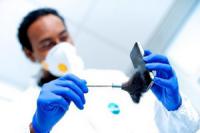-
New technique reveals a suspect's age by analyzing blood splatters
Researchers have discovered a new method of forensic analysis which could more accurately predict the age of criminal suspects based on samples of blood and saliva found at crime scenes. The study tested a technique which uses a form of artificial intelligence or “machine learning” to analyze a specific set of biomarkers in blood samples. The researchers were able to accurately predict the age of sample donors to within four years on average.
-
-
Crime scene fingerprints can move away from the original mark

New research has discovered that crime scene fingerprints can move after they have been deposited. The project, found a thin layer of material from a print can migrate across surfaces away from the original mark. Over a period of up to two months that material, around four millionths of a millimeter thick, will spread away from deposited fingerprint ridges, depending on the host surface.
-
-
Emergency retweets can help in times of disaster
Twitter and other social media tools are commonly used around the world. Now, many government and not-for-profit organizations have a presence on at least one of these systems and use them in various ways to share information about their activities and engage with people. For organizations that work in disaster zones and emergency situations, these tools can also be used to coordinate activities, help raise funds and disseminate timely news that can help in relief efforts.
-
-
U.S. crime rates declined in period of high immigration: Reports
The number of immigrants in the United States has risen from 3.5 million in 1990 to 11.1 million in 2014, but two new studies show that an increased number of immigrants in the country might have been associated with a historic decline in crime rates. The studies – Immigration and Public Safety from the Sentencing Project and Criminal Immigrants Their Numbers, Demographics, and Countries of Origin from the CATO Institute — also shows that immigrants are less likely than U.S.-born citizens to commit crimes and be imprisoned.
-
-
No wiretapping at Trump Tower: Senate, House intelligence leaders

Richard Burr (R-N.C.) and Mark Warner (D-Va.), the top two lawmakers on the Senate Intelligence Committee, on Thursday issued a statement to confirm that there is no evidence to back President Donald Trump’s assertion that Trump Tower was under surveillance. On Wednesday, Devin Nunes (R-Calif.) and Adam Schiff (D-Calif.), the leaders of the House Intelligence Committee, said there was no proof Trump was wiretapped during the administration of Barack Obama.
-
-
U.K. intel agency dismisses claim it helped wiretap Trump as “utterly ridiculous”
High-level British intelligence officials have angrily rejected an allegation that the U.K. intelligence service helped former president Barack Obama “wiretap” Donald Trump during the 2016 election. White House press secretary Sean Spicer repeated the claim in his Thursday press briefing. A spokesperson for the U.K. intelligence service dismissed Spicer’s claim as “utterly ridiculous.” A spokesman for Prime Minister Theresa May said on Friday: “We’ve made clear to the administration that these claims are ridiculous and should be ignored.”
-
-
In first, Israel’s Arrow-3 system intercepts Syrian missile fired at Israeli jet
Israel’s Arrow-3 system successfully intercepted a Syrian anti-aircraft missile that was shot at Israeli jets conducting a mission in Syria on Thursday night, the Israel Defense Forces said in a statement. It is the first time that the Arrow-3 system is known to have been used operationally.
-
-
Declassifying rescued nuclear test films
The United States conducted 210 atmospheric nuclear tests between 1945 and 1962, with multiple cameras capturing each event at around 2,400 frames per second. But in the decades since, around 10,000 of these films sat idle, scattered across the country in high-security vaults. Not only were they gathering dust, the film material itself was slowly decomposing, bringing the data they contained to the brink of being lost forever. For the past five years, physicists, film experts, archivists, and software developers have been on a mission to hunt down, scan, reanalyze, and declassify these decomposing films. The goals are to preserve the films’ content before it is lost forever, and provide better data to the post-testing-era scientists.
-
-
How online hate infiltrates social media and politics
In late February, the headline of a news commentary website that receives more than 2.8 million monthly visitors announced, “Jews Destroy Another One of Their Own Graveyards to Blame Trump.” With only a headline, this site can achieve something no hate group could have accomplished twenty years ago: It can connect with a massive audience. Looking at the most-visited websites of what were once diminished movements – white supremacists, xenophobic militants, and Holocaust deniers, to name a few – reveals a much-revitalized online culture. To whom, and how many, this latest conspiracy may travel is, in part, the story of “fake news,” the phenomenon in which biased propaganda is disseminated as if it were objective journalism in an attempt to corrupt public opinion. Today’s radical right is also remaking its profile, swapping swastikas and white-power rock for political blogs and news forums. The trappings may have changed, but the bigotry remains. Hate rhetoric repackaged as politics and housed in websites that look just like any other online blog can attract, or even persuade, more moderate ideologues to wade into extremist waters. This “user-friendly” hate community is joining forces in a way that could never happen in the offline world. Thanks in part to this connectedness, these poisoned narratives are now spreading well beyond racist websites.
-
-
If surveillance cameras are to be kept in line, the rules will have to keep pace with technology

The growing prevalence of cameras and greater understanding of the many ways in which we are surveilled has led many – including the current commissioner, Tony Porter, to voice concern that Britain is “sleepwalking into a surveillance state”. This raises critical questions about whether we can be confident that all these cameras are being used in a way the public would approve of – and if not, whether regulation can force CCTV operators into line. In the future, surveillance camera processes will become more opaque, more sophisticated, and potentially integrated with data from a variety of sources, including social media, meaning decisions about who to survey and who determines intensive surveillance will be determined by big data and algorithms. Any regulatory framework that does not or cannot keep up with the pace of change will soon become worthless.
-
-
Predicting crime knowledge states in the human brain
Judges and juries always ponder whether people act “knowingly” or “recklessly” during criminal activity — and neuroscience has had little to add to the conversation. But now, researchers have discovered that brain imaging can determine whether someone is acting in a state of knowledge about a crime — which brings about stiffer penalties — or a state of recklessness, which even in capital crimes such as homicide, calls for less severe sentences.
-
-
Predicting floods, hurricanes with social media

Social media can warn us about hurricanes, storms, and floods before they happen – according to new research. Key words and photos on social media can signal developing risks – like water levels rising before a flood. Researchers, who analyzed posts on Flickr between 2004 and 2014, found certain words – such as river, water, and landscape - take on distinct meaning of forecast and warning during time periods leading to extreme weather events. Words can be used as ‘social sensors’, to create accurate early warning system for extreme weather, alongside physical sensors.
-
-
Nuclear expert: “Real risk” that Iran and N. Korea cooperating on nuclear matters
There is a “real risk” that Iran and North Korea are engaged in illicit nuclear cooperation, a former United Nations weapons inspector and nuclear non-proliferation expert said. David Albright, president of the Institute for Science and International Security, called on the Trump administration to investigate any potential nuclear collaboration between the two nations.
-
-
The hollow threat of nukes
As President Trump signals that he wants to expand the nation’s nuclear arsenal, two experts say said nuclear weapons deter aggression, but that there is no evidence to support the common view that they are also useful as a coercive tool against adversaries. “[B]efore we spend $1 trillion buying new and more capable nuclear weapons, it’s worth taking a step back and asking, what is all of that money bringing us?” they said.
-
-
More effective response to unpredictable disasters
When the unthinkable happens and the unpredictable takes over, crises cannot be handled by the book. Traditional emergency work emphasizes fixed procedures and strong leadership, as is typically exemplified by the police force. This approach works in most emergency situations – but not when the unthinkable happens. Evaluations of past events show that the scale of many disasters could have been reduced if local decision-making power had been greater — that is, if the part of the team that was closest to the situation had been involved in a different way.
-
More headlines
The long view
Factories First: Winning the Drone War Before It Starts
Wars are won by factories before they are won on the battlefield,Martin C. Feldmann writes, noting that the United States lacks the manufacturing depth for the coming drone age. Rectifying this situation “will take far more than procurement tweaks,” Feldmann writes. “It demands a national-level, wartime-scale industrial mobilization.”
How Male Grievance Fuels Radicalization and Extremist Violence
Social extremism is evolving in reach and form. While traditional racial supremacy ideologies remain, contemporary movements are now often fueled by something more personal and emotionally resonant: male grievance.
The Surprising Reasons Floods and Other Disasters Are Deadlier at Night
It’s not just that it’s dark and people are asleep. Urban sprawl, confirmation bias, and other factors can play a role.
Why Flash Flood Warnings Will Continue to Go Unheeded
Experts say local education and community support are key to conveying risk.
